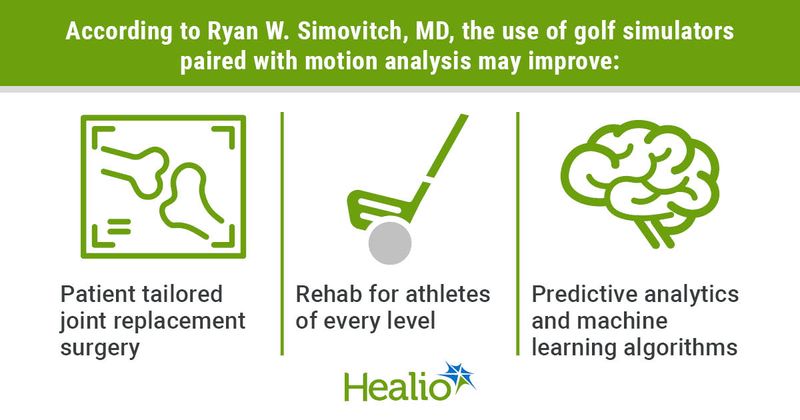Golf simulators, motion analysis may revolutionize TJR
Key takeaways:
- According to Ryan W. Simovitch, MD, golf simulators may change how joint replacement surgery is performed.
- Simovitch said simulators, paired with motion analysis, may allow for patient-tailored rehabilitation.
An upcoming study will aim to identify how joint replacement affects a patient’s golf game with use of a golf simulator paired with markerless motion analysis.
“As an extension of this study, it would be interesting to be able to follow these patients with a golf simulator and a DARI Motion analysis (DARI Motion) over time,” Ryan W. Simovitch, MD, director of the shoulder division and co-medical director at HSS Florida, the West Palm Beach location of Hospital for Special Surgery, told Healio. “What happens to a golf player with age? Independent of injury, as they move from 50 to 60 to 70 to 80 [years old], what is happening with their body mechanics and how has that impacted their ability to play golf?”

Patient-tailored approaches
For the study, Simovitch and colleagues are prospectively enrolling patients with arthritis undergoing joint replacement of the knee, hip or shoulder to use a golf simulator (Trackman) paired with the markerless DARI Motion analysis program before and after surgery. Simovitch said the enrollment process will include screening patients on their level of play.

“Prior to surgery, we bring them downstairs to our rehab facility, and we have them swing on the Trackman,” Simovitch, principal investigator of the study, said. “It is a combination of taking data points preoperatively with a sequence of clubs and strokes, and then it is also having the DARI, which is a motion analysis software package, do data acquisition for the motion of various body parts.”
At 6 months and at 1 year, the same data acquisitions will be used as patients are followed up postoperatively with the Trackman, according to Simovitch. He said use of this postoperative data may open the door to patient-tailored rehabilitation after joint replacement by identifying where patients can improve their golf game.
“[Golf simulators are] so far advanced for how you can standardize it to patients,” Simovitch said. “In particular, you can look at multiple characteristics like launch angle, ball spin rate and speed, club speed, dynamic loft, attack angle, club path, face angle, distance ball traveled and Smash Factor. All of those things, presumably, will have some impact on being able to tell us how our patients are rehabilitating and when their return to sport is going to be and at what level.”
Future avenues
In addition, Simovitch said the more data points that joint replacement surgeons can collect with the simulator and motion analysis, the better the ability will be to incorporate predictive analytics and machine learning algorithms to tailor procedures to individual patients.
“Right now, whether it is hip, knee or shoulder replacements, we have general principles that we obey when we go to the operating room and we put in a joint replacement. We may implant the prostheses with certain angles, distances and alignments, but those are basic principles and are not uniquely tailored to every individual patient,” Simovitch said. “But the more data points that we can collect unique to a specific patient, the more we would be able to make those choices more tailored to every patient using predictive analytics.”
While some of these technologies are already being used on elite level athletes at professional and semiprofessional levels, Simovitch said he hopes the technology will be used on athletes of every level. The current study may help pave the way for its broader use.
“If we can look objectively at outcomes with this, it would apply to all sports and all levels of sport play,” Simovitch said. “There are so many more amateur athletes who do not normally have the benefit of doing [motion analysis] that if we can identify sports specific principles of joint replacement, this may benefit athletes of all levels. The goal is to make motion analysis and simulator technology ubiquitous among amateur athletes and ‘weekend warriors’ to allow them to maximize their abilities and minimize risk of injury.”










